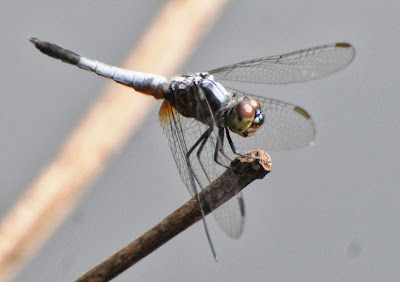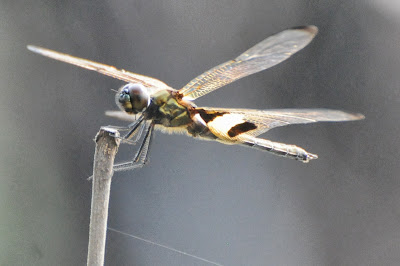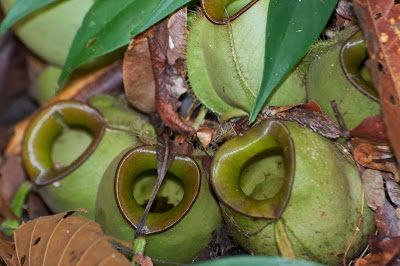That was the case on two morning trips I took with Hans on the weekend of September 24 and 25th, 2012. Fortunately, Hans is as eager as I am to see other things in nature than the object of our personal obsessions, so we both had a very good time.
On Saturday the 24th, we paid a visit to a stretch of forest that has survived in the heart of Kuching. Birders refer to it as the MJC Forest because it is situated in a development area of that name (which means that it is anybody's guess how long the forest will survive). It can, apparently, be a good place for birds (Hooded Pitta has shown up here), but we arrived a bit late in the day and found ourselves concentrating, instead, on the local Odonata. It is quite wet along the road edge, and as a result this seems to be an excellent spot for damselflies and dragonflies. This damselfly, certainly one of the most attractive I have seen, is Ceriagrion cerinorubellum.
Ceriagrion cerinorubellum is one of those favoured species that is common and beautiful at the same time. It is widespread from India to Southeast Asia, and is apparently one of the commonest damselflies in Singapore – though this was my first meeting with it.
Though this was the only damselfly we found, we did come across a number of dragonflies. Of course these included common species that I have seen many times elsewhere. I hope my readers are not getting too tired of seeing photographs of, for example, Neurothemis fluctuans.
Brachydiplax chalybea is only slightly less common.
The same can be said for Rhyothemis phyllis, though this is such a beautiful and elegant insect that I do not think I need to apologize for featuring it.
Ictinogomphus decoratus is another species in the common-but-irresistable category.
Brachydiplax chalybea is only slightly less common.
The same can be said for Rhyothemis phyllis, though this is such a beautiful and elegant insect that I do not think I need to apologize for featuring it.
Ictinogomphus decoratus is another species in the common-but-irresistable category.
Sometimes apparently common dragonflies merit a closer look. I snapped this quite poor photograph almost as an afterthought because I thought it featured Orthetrum sabina, a species I have photographed, even in wheel, almost too often. It was only later, on examining the result, then I realized that I had passed up a chance to get a better photograph of a far less common species, one that I have never seen before. These are Risiophlebia dohrni, a swamp forest specialist that can be hard to come by. Someday, I vow, I will get a more presentable picture – but, in the meantime, you can look at some excellent portraits here.
The road through the MJC forest seems to be a good spot for another rather uncommon dragonfly, Nannophya pygmaea - an insect with the distinction of being one of the smallest, if not the smallest, dragonfly in the world. Though I had seen the female before, this wa my first encounter with the brilliant red-and-black male.
Sunday found us further afield, at one of Hans's favourite spots along the edge of Kubah National Park. This, as I have described in an earlier post, is a good spot for Nepenthes ampullaria.
It is also a good place to find plants I can't identify at all. What on earth is this?
Or this? The double drip-tips are remarkable!
This is an aroid, I suppose, but which one?
I don't even bother trying to identify fungi, but I do find their variety interesting.
No snakes, of course; but among the other interesting animal life we encountered were a predatory wasp and its victim, a cricket.
This Branded Imperial (Eooxylides tharis) appears to have survived its own brush with a predator, perhaps a bird or small lizard, that has made off with its protruding white tails (and a good bit of the rest of the hindwing in the bargain).
Here is one of the more iconic of Southeast Asia's predatory invertebrates, the fantastic horned spider Gasteracantha arcuata, clinging to a mossy tree-trunk.
Mammals can be as hard to come by as snakes, but we did manage a lengthy encounter with a Black-eared Pygmy Squirrel (Nannosciurus melanotis). This is the only member of its genus, and is confined to Borneo, Sumatra and Java.
Like other pygmy squirrels in Borneo, this species seems to spend most of its time clinging to tree trunks – in this case, fairly high up, and mostly head down.Sunday found us further afield, at one of Hans's favourite spots along the edge of Kubah National Park. This, as I have described in an earlier post, is a good spot for Nepenthes ampullaria.
It is also a good place to find plants I can't identify at all. What on earth is this?
Or this? The double drip-tips are remarkable!
This is an aroid, I suppose, but which one?
I don't even bother trying to identify fungi, but I do find their variety interesting.
No snakes, of course; but among the other interesting animal life we encountered were a predatory wasp and its victim, a cricket.
This Branded Imperial (Eooxylides tharis) appears to have survived its own brush with a predator, perhaps a bird or small lizard, that has made off with its protruding white tails (and a good bit of the rest of the hindwing in the bargain).
Here is one of the more iconic of Southeast Asia's predatory invertebrates, the fantastic horned spider Gasteracantha arcuata, clinging to a mossy tree-trunk.
Mammals can be as hard to come by as snakes, but we did manage a lengthy encounter with a Black-eared Pygmy Squirrel (Nannosciurus melanotis). This is the only member of its genus, and is confined to Borneo, Sumatra and Java.
There seems to be very little information about this squirrel's natural history, so I have no idea what it might be finding to eat on the bark. Anyway, as the lower shot shows, it does occasionally turn right side up. Borneo's particularly rich squirrel fauna is one of its lesser known natural history secrets, and it appears that we still have a good deal to learn about their lives.
























+DSC_4250.jpg)



+DSC_4202.jpg)
+DSC_4218.jpg)
+DSC_4219.jpg)
+DSC_4221.jpg)
+DSC_4222.jpg)
No comments:
Post a Comment